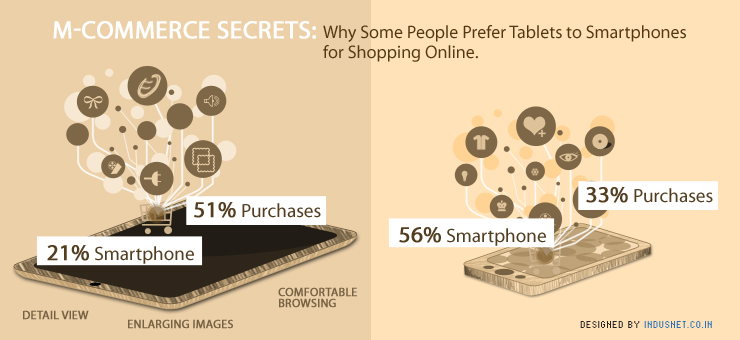
While designing websites or ecommerce websites, we must take into account the importance of mobile devices in shopping decisions. It is widely understood that an increasing number of people have begun to use their tablets and cellphones to purchase products. They offer convenience, portability and ease of use. Ecommerce websites tend to be designed for web browsers and not for tablets or smartphones,. If you are a company that needs a website to sell your products or services, you might want to know where your target audience usually prefers to shop.
M-commerce is a trend that is getting popular thanks to standardization of solutions, platforms and applications. M-commerce refers to purchases made on smartphones, tablets and sometimes even on feature phones. There certainly seems to be a difference between the way people purchase on smartphones and tablets. The advantage is clearly on the side of the latter.
Tablet Users Purchase More than Smartphone Users
The conclusion is surprising when we take a look at the penetration of both technologies. 21% of the population has a tablet, and the population able to access the Internet via a smartphone is much greater: 56%. When it comes to actual purchases, the numbers make it really clear, who the real winner is. 33% of smartphone users use it to buy, but 51% of tablet owners make purchases on their tablets.
Tablets Are Generally Better Suited for Purchases
Obviously, the issue of navigation and purchases cannot be reduced to the subject of penetration of a device. A tablet seems better suited for e-commerce in general. The general perception is that they are more comfortable and better suited to web browsing or glancing through product images. Therefore, it is most often used at home or on the move to purchase products. Moreover, tablets often have applications that are well suited for enlarging images and looking at details. Often, people prefer to buy clothes and even art using tablets as they can enlarge images and take a good at details. This preference for details often leaves smartphone users feeling handicapped, which is probably why they often just take a look at the products and then das to the nearby store to purchase what they want.
What People Buy on Smartphones and Tablets
If you were wondering what sorts of products are purchased more often on tablets and smartphones, a study suggested that people purchase differently on smartphones and on tablets. Music and video (whether physical or digital), games, software, clothing, cosmetics and health products are more often purchased by smartphone users than tablet users. Conversely, everyday products, such as food, electronics and appliances, tickets, gifts or entertainment and cinema tickets are purchased tablet users. It should be noted that books are purchased by both the two populations without any significant differences.
Who Uses Tablets and Smartphones
When we look at the demographics, tablet users are older as a rule, mainly because of higher shelf prices. Smartphone users tend to be more diverse and more mobile, which probably explains why they may choose to shop in real than online. Tablet users tend to be more engrossed in their devices partly because of their ease of use and partly because those who purchase tablets tend to be more tech savvy than general smartphone users. Tablet users also carry smartphones themselves, which make them more tech savvy than those who carry only smartphones. All these things go into consideration when we try to understand why a subgroup purchases differently than the other.
If we consider these points and ponder upon them, it is easy to surmise that we must first understand where our target audience really is. If they are usually on smartphones, you will do better by optimizing your website for smartphones. If they are found shopping on tablets more often, you might want to consider that factor as well. At the end of the day, responsive web designing takes care of all screen types. However, a little knowledge into consumer behavior can go a long way in ensuring commercial success. Simply put, mobile commerce is the future of online shopping. If we understand the trends as they begin to unfold, we will be better prepared for the future.